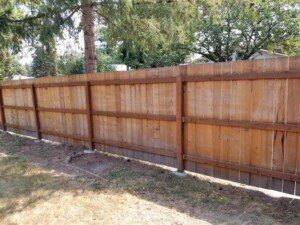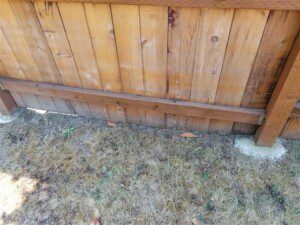
Fences are typically composed of either wood, metal, composite, PVC, and masonry. While there are pros and cons to each of these types of fencing materials, wood is the most common type used at most homes today. The most popular wood types include Douglas fir, pine, cedar, cypress, and redwood. Pine and fir woods are typically inexpensive and easy to work with while cedar, cypress, and redwood are more expensive but usually last longer.
Using pressure treated wood for the fence posts is recommended as this will help to prevent early deterioration and decay. Pressure treated wood is wood that has been put through a process that uses high pressure to force a mixture of water and preservatives deep into the wood to help extend its lifespan. This type of wood is commonly used for fence posts as these posts are in contact with the ground, which increases the potential for moisture in the soil to cause rot and decay.

Hardware in the fence should also have all of the holes filled with the appropriate fasteners. A common cause for early failure or sagging in a fence is hardware that was installed without all of the necessary fasteners, leading to the fence framing members to become loose or to become disconnected. Check for missing hardware and fence connections and for gaps in the hardware where fasteners should be driven.
Fence boards should be installed with a small gap between the wood and the ground to help prevent early deterioration. This gap should be a minimum of two inches in order to prevent the wood from absorbing moisture. Moisture and soil contact can cause the boards to swell and rot and can make the wood an easier target for wood destroying organisms. Wood in contact with the ground can allow pests such as termites and carpenter ants to gain a foothold and significantly damage a fence. If having a gap under the fence is a problem due to pets or children, a rot board can be used instead. These boards, also called kickboards, are set horizontally under the fence boards and are composed of pressure treated wood like the fence posts to help prevent deterioration and discourage pests while in contact with the soil.
